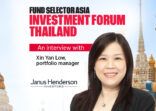What proportion of Henderson’s overall mutual funds business is offshore?
Greg Jones: A rough approximation is we have £16bn in the UK and about £8bn in Steven’s continental Europe business. The Latin American business is quite small, about £200m, because we only started a couple of years ago. We then have £700m in retail in Asia and $7bn (£4.35bn) in US mutual funds.
Steven de Vries: That’s a reflection of where we came from, and where we’re heading. We came from being very UK-focused and UK-centric, not just because it’s a British company, but also because of the nature of the client base – most of the clients were and are based in the UK.
Also, our IFA business, especially after the acquisition of New Star, has grown considerably. After the New Star and Gartmore acquisition, the horizon has become much broader.
We now have stronger and faster growth in the regions outside the UK. Continental Europe has done extremely well this year but also Asia and the US are growing.
The LatAm figure is a bit flatter because there’s a strong growth momentum there, from both the retail and institutional sides. The current state is that we’re emerging from being a UK-focused house into a more global asset manager.
Can you paint me a picture of the type of regulatory structures you have to deal with to cover all of the places Henderson operates in?
GJ: In the US we have our own mutual fund range, with an independent board, with some employees sitting on that board. That is a standalone business in the way in which it is regulated.
In the UK, we are working very closely with the Financial Conduct Authority, particularly around guidelines of customer information and the sort of informational flow that goes to customers to make it more understandable for the end retail investor.
In Luxembourg we have a Sicav, which is part of the product range that is growing most quickly, due to the international dimension of our expansion. The range is registered to 27 countries and we sell it in Hong Kong and Singapore.
We also have some Singaporean funds, but it’s a very small range, catering for the local market.
What’s the size of the fund range in terms of assets?
GJ: We have two Sicavs, one of which we inherited from the Gartmore days and the other, an existing Sicav called Horizon.
The Horizon fund range is currently about $14bn and the Gartmore Sicav $2.5bn, so that is in total about €16.5bn of assets under management in our offshore range.
I would say 90% of our clients come from Europe and 10% from Asia. Then we have our UK Oeic range, which is massive, partly because of the old Henderson range, which was reasonably exhaustive but also structured mainly for a UK client audience. We also have the Gartmore and New Star Oeic businesses being thrown in as well – we have about 120 institutional Oeics and unit trusts.
How much is local and expat business in terms of the mix?
SD: That’s a difficult question. One thing we lack is a properly good insight into the AUM of our clients. Just as an example, if you look at the large global players, whether it’s HSBC, UBS or Credit Suisse, there’s just one nominee account and, for us, it’s very difficult to understand where business is coming from. Greg in the UK team focuses much more on expats.
GJ: There is also the international life company business, a small part of our business, which is mainly done through what we call the wholesale channel. So it’s working closely with a number of the large banks across the continent.
We’ve also got a little business in Israel, where we work with some pension funds and institutions.
We tend not to work with IFAs based in Dubai, because we’re not really set up for it.
We’re a business that’s gone through some acquisitions, and we’ve had that period of blending everything together and the indigestion that comes with that. We’re now at the stage where we’re thinking, ‘Which areas can we look to help globalise Henderson as a business?’
We do have a global footprint, but we’re not yet a truly integrated global business. Two-thirds of our client money is run on behalf of pan-European investors, but not everyone in Asia and South America thinks European equities or European fixed income is the best thing since sliced bread.
We added resource and changed the management of our global equity franchise about a year and a half ago. It’ll take probably another two years before we get serious traction there.
One of the areas where Henderson needs to add some resource could be in globalising fixed income, for example. A very high percentage of the fixed income money we run is on behalf of UK and European clients, and a high subset of that is in credit.
We don’t have too many US clients. If we want to have them we’d need an asset management presence in the US.
We pinched a team of six fund managers from a company called Delaware Asset Management in Philadelphia. These guys are high-yield specialists. We launched a US mutual fund – a global high-yield fund – for them in April this year, and we’ll be launching a Sicav we can then market around the rest of the world.
A global high-yield vehicle can go alongside a European high-yield fund, for example, which we launched in November last year, and a total return bond fund that is a “go anywhere, do anything” fund, targeting a 6% a year total return. We launched that in April last year, which has got £500m in it [now].
What is happening in the Latin America market?
GJ: There are two main subsets of clients we see in Latin America – the private banks, where many of the gatekeepers sit in Miami and New York, and also US offshore investors, who often operate or invest via Miami.
In addition, we target pension funds now, in Chile, Peru, Colombia and Mexico. We’ve just formed a joint agreement with Santander as part of its global products group, where we’re doing some joint advertising and marketing in Mexico for Santander private banking in Mexico. We’ve also just joined a similar venture with Banco Itaú in Brazil.
So, from three years ago having no business in any of those markets we now have client business in Chile, Peru, Mexico, Brazil and also in Uruguay, where we’ve hired an agent to work for us, and Miami.
As LatAm investors start to get disenchanted with their own equity markets, the first developed market it moved to, as you would expect, is US equity, but they’re just now starting to look at European equities. We’re receiving reasonable flow both into European equities long only and also European equity long/short vehicles.
There’s obviously more risk in going into overseas markets that you don’t know so well. What do you do in terms of risk mitigation?
GJ: We tiptoe in to these markets rather than going in all guns blazing. We tend to work initially with local representatives. We did that in the case of Chile and Israel, which is another market where not many of our competitors go.
We only do this by first understanding the local regulations and what we can and can’t do, such as who we can and can’t promote to. We have conversations with the regulators in each of the countries we go into, as well, just to make sure we comply.
Brazil is a relatively closed market where domestic institutions take the lion’s share of the money. Our only route into Brazil without opening an office is partnering with a business that’s there or in a joint venture.
How do you predict Henderson will look in terms of its mix of business and geography around the world?
SD: The key ambition, at least for Europe, is to have a diversified client base and product range. Traditionally, Henderson has been seen as a pure equity house. Especially after the Gartmore acquisition, we are positioned as one of the largest and strongest European equity teams.
We have a good technology team and great property teams but it has skewed our business towards equity, which brings the risk of being very linked to fluctuations in the market. My ambition is that in three to five years we will have a 50:50 split between fixed-income and equity products in terms of assets.
In terms of client base we’ve always been focusing on what we call wholesale – the private banks, the discretionary managers, family offices – and the ambition is also to grow our retail business.
Markets in which we could see that developing would be Italy, Germany or potentially the Netherlands, where we’ve built a good brand. The other ambition is to grow the business to make it a similar size and significance to the UK business.
GJ: The business itself has five key pillars we’re looking to major on in the next five years. It’s global equities and global fixed income, whereas at the moment we major in regional equities and regional fixed income. It’s absolute return strategies with a clear emphasis on long/short.
It’s multi-asset investment solutions, particularly those that generate income, because we think the ageing population and low interest rates will mean people will continue to focus on looking for income solutions spread across asset classes. We know we’re good at European equity, so that is one of our five pillars, too.
What I’d expect to see from Henderson over the next five years is new and innovative products coming out of these areas and, in some areas, maybe some straightforward plain vanilla products.
It’s about globalising the product ranges, giving our clients some choice and focusing on what we are – an active manager.
















